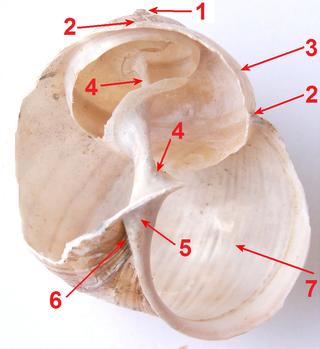
The aperture is an opening in certain kinds of mollusc shells: it is the main opening of the shell, where the head-foot part of the body of the animal emerges for locomotion, feeding, etc.

The body whorl is part of the morphology of the shell in those gastropod mollusks that possess a coiled shell. The term is also sometimes used in a similar way to describe the shell of a cephalopod mollusk.

A whorl is a single, complete 360° revolution or turn in the spiral or whorled growth of a mollusc shell. A spiral configuration of the shell is found in numerous gastropods, but it is also found in shelled cephalopods including Nautilus, Spirula and the large extinct subclass of cephalopods known as the ammonites.

A spire is a part of the coiled shell of molluscs. The spire consists of all of the whorls except for the body whorl. Each spire whorl represents a rotation of 360°. A spire is part of the shell of a snail, a gastropod mollusc, a gastropod shell, and also the whorls of the shell in ammonites, which are fossil shelled cephalopods.

The Bactritida are a small order of more or less straight-shelled (orthoconic) cephalopods that first appeared during the Emsian stage of the Devonian period with questionable origins in Pragian stage before 409 million years ago, and persisted until Carnian pluvial event in the upper middle Carnian stage of the Triassic period. They are considered ancestors of the ammonoids, as well as of the coleoids.

The operculum is a corneous or calcareous anatomical structure like a trapdoor that exists in many groups of sea snails and freshwater snails, and also in a few groups of land snails; the structure is found in some marine and freshwater gastropods, and in a minority of terrestrial gastropods, including the families Helicinidae, Cyclophoridae, Aciculidae, Maizaniidae, Pomatiidae, etc.

A protoconch is an embryonic or larval shell which occurs in some classes of molluscs, e.g., the initial chamber of an ammonite or the larval shell of a gastropod. In older texts it is also called "nucleus". The protoconch may sometimes consist of several whorls, but when this is the case, the whorls show no growth lines.

The gastropod shell is part of the body of a gastropod or snail, a kind of mollusc. The shell is an exoskeleton, which protects from predators, mechanical damage, and dehydration, but also serves for muscle attachment and calcium storage. Some gastropods appear shell-less (slugs) but may have a remnant within the mantle, or in some cases the shell is reduced such that the body cannot be retracted within it (semi-slug). Some snails also possess an operculum that seals the opening of the shell, known as the aperture, which provides further protection. The study of mollusc shells is known as conchology. The biological study of gastropods, and other molluscs in general, is malacology. Shell morphology terms vary by species group.
In anatomy, a suture is a fairly rigid joint between two or more hard elements of an organism, with or without significant overlap of the elements.
This page provides a glossary of plant morphology. Botanists and other biologists who study plant morphology use a number of different terms to classify and identify plant organs and parts that can be observed using no more than a handheld magnifying lens. This page provides help in understanding the numerous other pages describing plants by their various taxa. The accompanying page—Plant morphology—provides an overview of the science of the external form of plants. There is also an alphabetical list: Glossary of botanical terms. In contrast, this page deals with botanical terms in a systematic manner, with some illustrations, and organized by plant anatomy and function in plant physiology.

The columella or pillar is a central anatomical feature of a coiled snail shell, a gastropod shell. The columella is often only clearly visible as a structure when the shell is broken, sliced in half vertically, or viewed as an X-ray image.
The following is a glossary of common English language and scientific terms used in the description of gastropods.

Gymnobela engonia is a species of sea snail, a marine gastropod mollusk in the family Raphitomidae.

Kurtziella acanthodes is a species of sea snail, a marine gastropod mollusk in the family Mangeliidae.
Pleurotomella perpauxilla is a species of sea snail, a marine gastropod mollusk in the family Raphitomidae.
Pleurotomella pudens is a species of sea snail, a marine gastropod mollusk in the family Raphitomidae.

Spirotropis lithocolleta is a species of sea snail, a marine gastropod mollusk in the family Drilliidae.

Spirotropis phaeacra is a species of sea snail, a marine gastropod mollusk in the family Drilliidae.

Mohnia carolinensis is a species of sea snail, a marine gastropod mollusk in the family Buccinidae, the true whelks.

A prodissoconch is an embryonic or larval shell which is present in the larva of a bivalve mollusk. The prodissoconch is often but not always smooth, and has no growth lines. It is sometimes still present and visible in the adult shell, if there has been no erosion of the shell in that area.



















